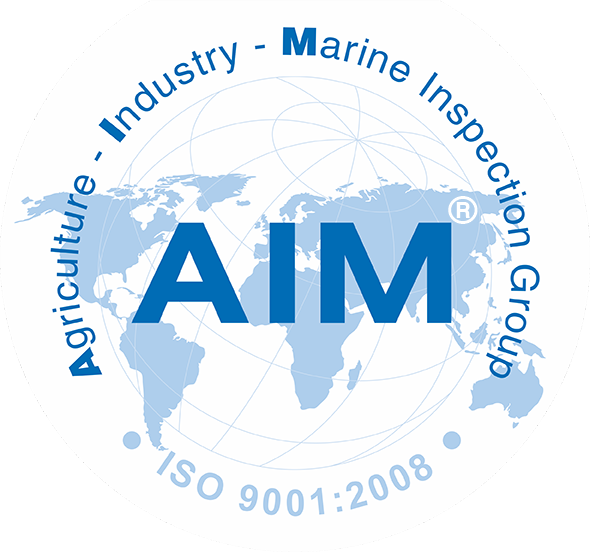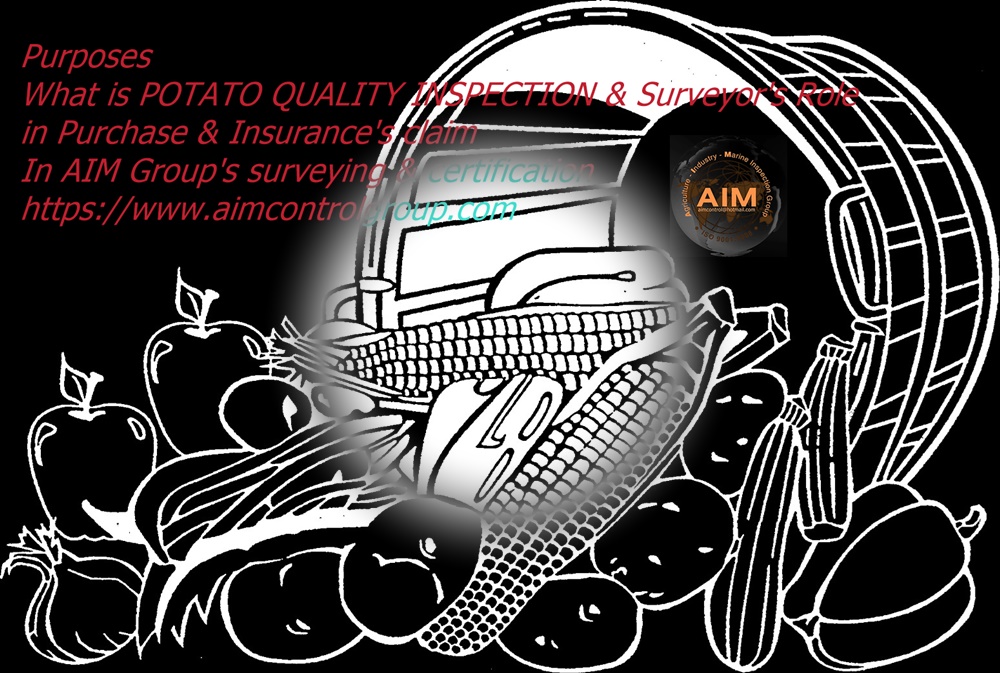Quality potato inspection and certification
Quality potato inspection and certification
At AIM Group, providing the services of quality potato inspection and certification for best agreements in quality and quantity standards as well as claim adjusting.
Our data is the evidence that all national quality and International phytosanitary requirements are met.
Our inspection of quality potatoes provides seed for issuing potato certification through field, post-harvest winter testing and laboratory.
All seed potato fields to be certified under the Standard must be inspected during growth.
AIM Control's inspectors are to inspect tubers within a lot to establish whether they meet the standards for certification, after sorting and sizing but before dispatch.
1. Representative Sampling
-
size of samples
-
number of samples
-
hipping point
-
market
-
inspection of bulk loads or bulk bins
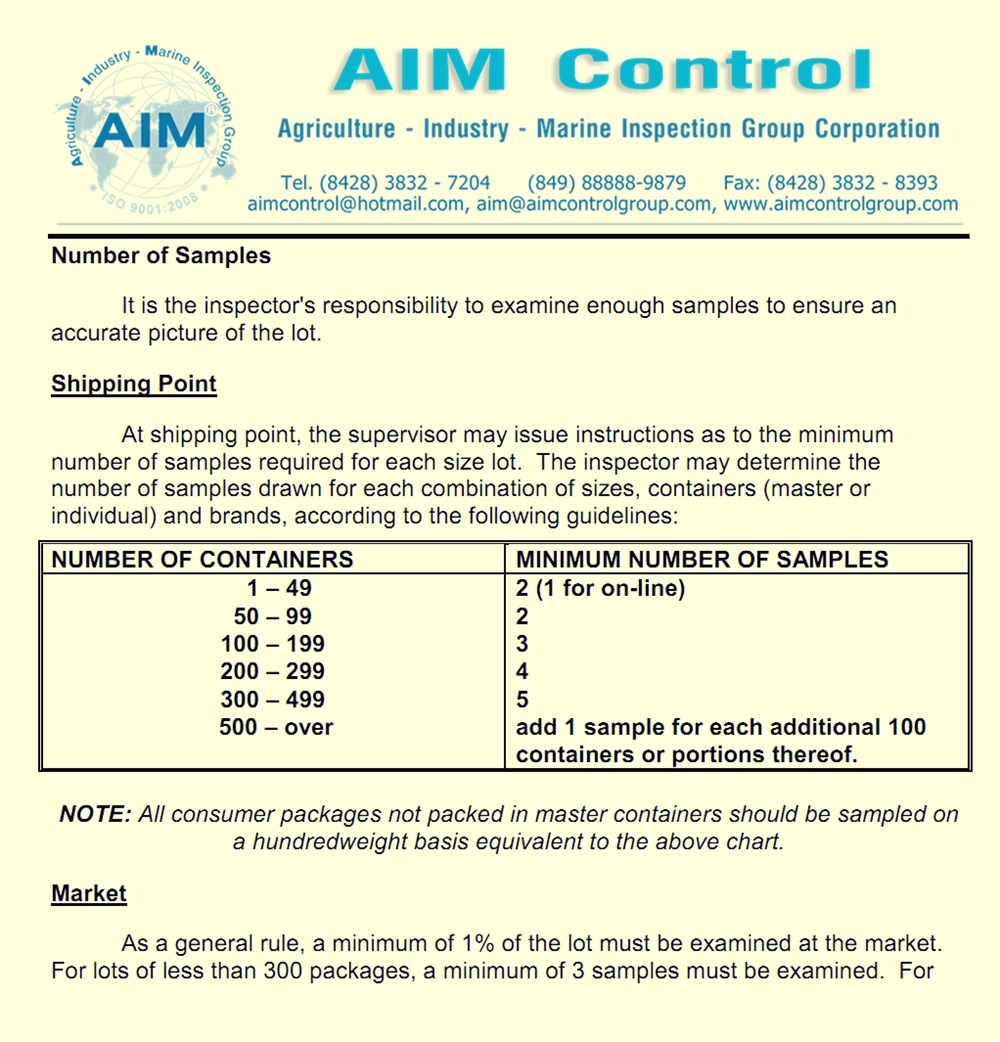
2. Tolerances
-
summary of tolerances
-
application of tolerances
-
summary of application of tolerances
-
notesheet and certificate
3. Product
-
number/type of containers
-
brands/markings
-
origin
4. Condition Of Pack
-
temperature of product
-
reporting size
-
reporting percentages of a specified size and larger
-
certifying minimum size
-
certifying maximum size
-
reporting overweight
-
containers marked to size or count
-
certifying size without reference to grade
-
use of undersize and oversize within tolerance
-
when undersized or oversized specimens are also
5. Defective
-
maturity and skinning.
-
maturity/skinning classification to be used upon request.
-
combination of internal and external defects
DEFECTS (QUALITY AND CONDITION)
1. EXTERNAL DEFECTS QUALITY POTATO INSPECTION:
-
Air cracks (C)
-
Bruises (Q&C)
-
Cleaness (Q)
-
Adhering dirt and staining
-
Loose dirt, clods of dirt, rocks or other foreign matter.
-
Cuts/clipped ends (Q)
-
Corky ring pot (C)
-
Dries stems
-
Elephant hide (Q)
-
Enlarged lenticels (Q & C)
-
External surface discoloration (C)
-
Firmness (C)
-
Folded ends (Q)
-
Flattened or depressed areas (C)
-
Flea beetle (Q)
-
Freezing/freezing injury (Q & C)
-
Grass damage (Q)
-
Greening (C)
-
Growth cracks (Q)
-
Grub damage (Q)
-
Mechanical damage (Q)
-
Nematode (root knot) (Q)
-
Pink eye (C)
-
Rhizoctonia (black scurf) (Q)
-
Rodent and bird damage (Q)
-
Rough raised netting (Q)
-
Russeting (Q)
-
Scab (Q)
-
Pitted scab (Q)
-
Russet scab (Q)
-
Surface scab (Q)
-
Powdery scab (Q)
-
Second Growth (Q)
-
Shape (Q)
-
Silver Curf (C)
-
Similar varietal characteristics (Q)
-
Skin Checks (C)
-
Sprouts (external) (C)
-
Individual sampling and reporting requirements for sprouts
-
Quality for sprouts.
-
New potato growth attached by fleshy stems (Q)
-
Sunburn (Q)
-
Sunken Discolored Areas (C)
-
Sunken discolored areas with underlying flesh discolored (C)
-
Sunken discolored sticky areas (C)
-
Surface cracks (Q)
-
Tuber moth damage (C)
-
Wireworm (Q)
2. INTERNAL DEFECTS QUALITY POTATO INSPECTION:
Sampling to determine the presence of internal defects
Methods of cutting to determine !nternal defects
Method of cutting to determine external or internal waste.
-
Blackheart (C)
-
Heat or drought necrosis (Q)
-
Hollow heart or hollow heart with discoloration
-
Ingrown sprouts (C)
-
Internal black spot (C)
-
Internal brown spot (Q)
-
Internal mahogany browning (C)
-
Internal pink to purple discoloration (C)
-
Internal potato necrosis (C)
-
Light brown discoloration (brown center) (Q)
-
Net necrosis (C)
-
Stem end browning (C)
-
Vascular discoloration (C)
-
The maximum area allowed of hollow heart, hollow heart with discoloration, or light brown discoloration (brown center)
DRY ROT, SOFT ROT AND WET BREAKDOWN.
-
Classifying and certifying rots
-
Alternaria tuber rot (early blight) (C)
-
Bacterial ring rot (C)
-
Blackleg tuber rot (C)
-
Brown rot (southern bacterial wilt) (C)
-
Fusarium tuber rot (C)
-
Jelly end rot (glassy end rot) (C)
-
Late blight tuber rot (C)
-
Leak (C)
-
Pink rot (C)
-
Sclerotium rot (C)
-
Slimy soft rot (C)
-
Wet breakdown (C)
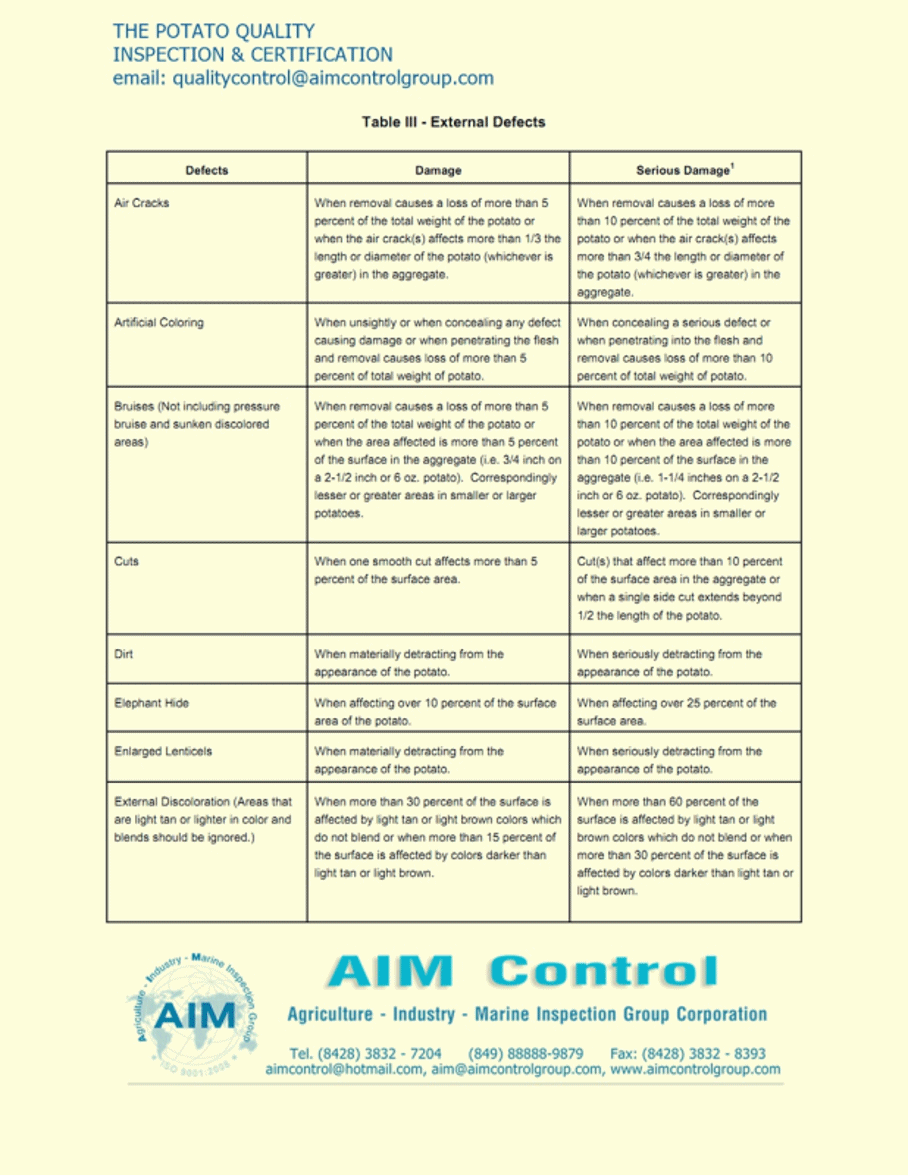
TOLERANCES
Tolerances. To allow for variations incident to proper grading and handling in each of the foregoing grades, the following tolerances by weight or equivalent basis, are provided as specified.
(a) For defects.
First class:
Second class:
Third class:
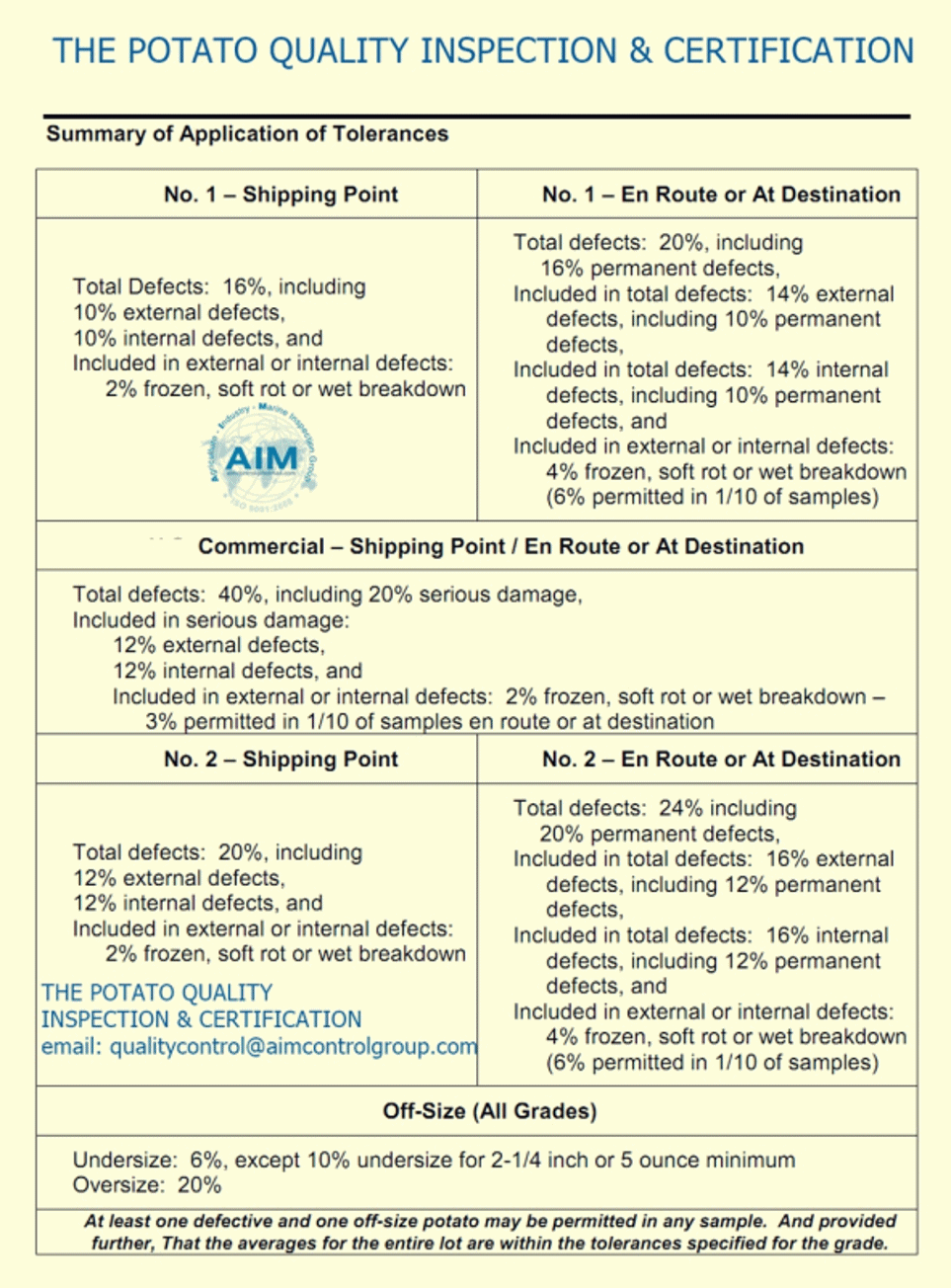
Product
The common name “Potatoes” will be used to describe this commodity in the
product heading. Color and/or type shall be used in conjunction with “Potatoes” such as “Long White," “Round Red," “Round White,” “Russet,” “Other," or “Mixed.”
The term “Other” is applied to potatoes that have skin and/or flesh colors that differ from white flesh potatoes that have white, red, or russet skin. For example, potatoes having yellow flesh, or having bi-colored skin, or having purple skin and flesh, etc., would be described as “Potatoes, Other." When needed, the potatoes can be further described in the “OTHER” or “REMARKS” section, such as “Yellow flesh potatoes,” “Bi-color red and yellow potatoes,” or “Purple skin and flesh potatoes.”
The term “Mixed” is applied to lots having different types and/or colors of potatoes packed in the same container or master container. For Example, consumer units with round red, white, and purple potatoes would be described as “Potatoes, Mixed.” Again, additional description can be reported in the “OTHER” or “REMARKS” section, such as “Round red, white, & purple potatoes mixed in bags.”
Fingerling Potatoes
Fingerlings are small thin-skinned potatoes. There are several varieties of fingerling potatoes including French, Russian, Austrian, and American. These varieties can be red-skinned, tan-skinned, or purple-skinned.
Number/Type of Containers
The number of containers will always be reported. At shipping point locations for stationary lot certification, AIM Group's inspector shall always verify the container count provided by the applicant for each lot and report it as the “inspector’s count.”
Potatoes are packed in many types of containers. They are commonly packed in volume filled fiberboard cartons or paper bags holding 50 pounds.
Brands/Markings
The brand, variety, size, count, grade, weight, point of origin and other important information appearing on the container should be reported on the notesheet in the “Brands/Markings” section. Only the brand name and other key markings necessary to properly identify the lot for certification should appear in this section on the certificate of AIM Group.
Origin
Our inspector should not make a positive statement on their own authority, but when container markings list the state or country of origin, it should be quoted in the appropriate space on the notesheet and the certificate. AIM Group can certifies only to the marks and has no means of verifying in which state or country the potatoes were grown.
Condition of Pack
Potatoes are in the Packaging using the following terms:
Well filled means the contents are level with top edge of the container.
Fairly well filled means the contents are not in contact with the lid or cover, but not more than 1-1/2 inches below the lid or cover.
Slack means the contents are more than 1-1/2 inches below the lid or cover. Report the amount of slackness in inches or fractions of inches below the lid.
Temperature of Product
AIM Control's Inspectors would not normally determine or report temperatures at shipping point. However, due to the importance of the pulp temperature of fresh fruits and vegetables when in transit or at destination, it is essential that the inspector accurately determine and report the temperature or range in temperatures on each lot.
Maturity and Skinning
The Standards for Grades of Potatoes do not have any maturity or skinning requirements.
Mature. “Mature" means that the skins of the potatoes are generally firmly set and not more than 5 percent of the potatoes in the lot have more than one-tenth of the skin missing or “feathered."
Fairly well matured. “Fairly well matured" means that the skins of the potatoes are generally fairly set and not more than 10 percent of the potatoes in the lot have more than one-fourth of the skin missing or “feathered."
The term “Mature” should be used to describe potatoes which have reached full development, are firm, and have a tough and tight skin. The term “Fairly Well Matured" has the same definition as “Slightly Skinned”
Skinning definitions:
Skinning. (a) The following definitions provide a basis for describing lots of potatoes as to the degree of skinning whenever description may be appropriate:
(1) "Practically no skinning" means that not more than 5 percent of the potatoes in the lot have more than one-tenth of the skin missing or "feathered;"
(2) "Slightly skinned" means that not more than 10 percent of the potatoes in the lot have more than one-fourth of the skin missing or "feathered;"
(3) "Moderately skinned" means that not more than 10 percent of the potatoes in the lot have more than one-half of the skin missing or "feathered;" and
(4) "Badly skinned" means that more than 10 percent of the potatoes in the lot have more than one-half of the skin missing or "feathered."
SIZES:
Size A: AIM Group’s certifying on the basis of Size A, it is necessary to clearly indicate whether or not 40% by are 2-1/2 inches (6.35 cm) in diameter or bigger, or are 6 ounces (0.17 kilograms) weight or heavier.
AIM Group certified minimum size: When minimum size is specified in the class, minimum diameter 2 inches (5.08 cm) or minimum weight 4 ounces (0.113 kg)
AIM Group certified Maximum Size
"Medium," a potato larger than 3-1/4 inches (8.255 cm) in diameter or weighing more than 10.49 ounces (0.2974 kg) is considered oversize
Combination of Internal and External Defects
When cutting for internal defects (20 pounds or entire sample), a potato with an external defect is found to have an internal defect, and either defect would be scorable by itself.
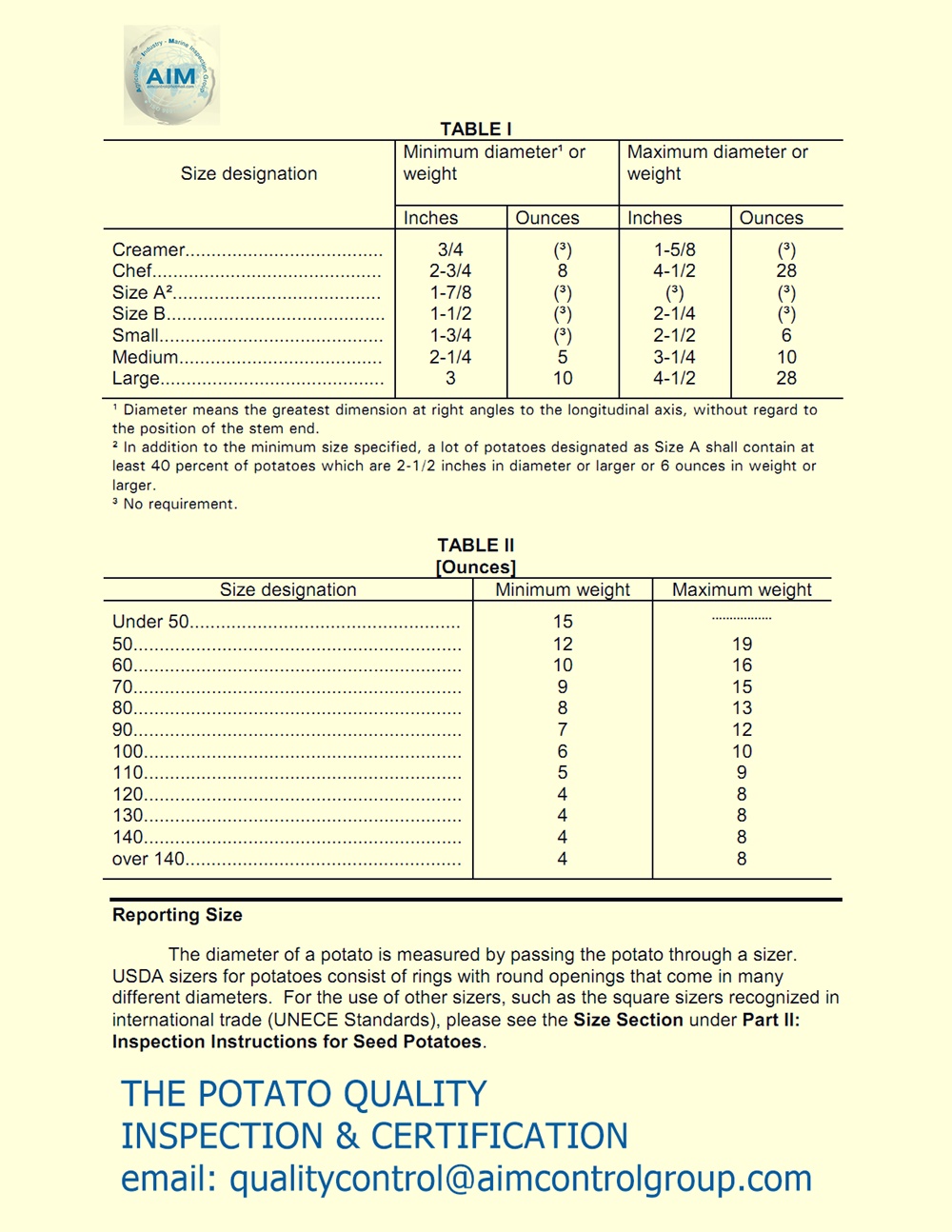
DEFECTS (QUALITY AND CONDITION)
Statements pertaining to freshness, maturity, shape, color, the amount and type of defects, and the amount of decay are shown under the results of inspection of AIMGroup.
Factors noted with (Q) are considered as QUALITY only. Quality (also referred to as “permanent" defects) are defects which do not change during storage or shipment (shape, scars, etc.).
Factors noted with (C) will be reported as CONDITION on market
certificates. Condition defects are factors that are subject to change during shipment or storage, such as sunken discolored areas, internal black spots, and soft rot. Those factors noted with (Q or C) may be considered as QUALITY or CONDITION.
The grades specify certain factors that are basic to describing the quality and condition of a lot such as "cleanness," "firmness" and "shape." These may be described in general terms unless they fall below the requirements of the grade.
All photo visual aids referred to are found in AIMGroup "Official Visual Report for Potatoes”
EXTERNAL DEFECTS
External defects. “External defects" are defects which can be detected externally. However, cutting may be required to determine the extent of the injury.
Noted:
When inspecting potatoes, they cannot be held to the same standard of perfection that is required of fruits and many vegetables. lt is almost impossible to remove all defects by the ordinary process of commercial grading; furthermore, slight blemishes do not affect the value of the potatoes as they do in the case of many other products.
Damages Calculated by AIMGroup inspectors:
1. For Serious Defects:
Slight Damage:
When removal causes a loss exceeding 5% of the total weight of the potato on each defect kinds
Damage:
When removal causes a loss exceeding 10% of the total weight of the potato on each defect kinds.
2. For Minor defects:
Slight Damage:
When removal causes a loss exceeding 11% to 19% of the total weight of the potato on each defect kinds
Damage:
When removal causes a loss exceeding 20% to 50% of the total weight of the potato on each defect kinds.
Air Cracks (C)
This defect is characterized by longitudinal cracks, often fresh and without apparent connection with mechanical injury. They usually occur during the harvesting and packing process, although some may occur after packing in very tight packs or if the package is handled roughly.
Bruises (Q & C)
Bruises are one of the most common defects found in potatoes. Bruises generally show discoloration which may vary as to color but will usually be of a brown, gray or black shade. The skin and flesh of the potato may be broken or torn or may simply show discoloration. The size and shape of a bruise may vary considerably.
Our inspectors make experience the distinction as to whether the bruise is “old” or “fresh." Old bruises are considered quality defects. Fresh bruises are considered condition defects.
When the age of the bruise is in making a determination:
Fresh bruises are typically a shade of pink or a bright shiny gray to jet black in color and show no sign of dry or dry starchy flesh.
Old bruises are typically dull gray or light brown and other colors which show a dry or starchy appearance in the flesh. Also, old bruises may show a separation or some corkiness of the flesh.
Noted:
the flesh next to the deposit is affected, the condition has been caused by some decay. If the flesh is sound, it should be considered only as a bruise.
Cleanness (Q)
All Lots approximately 90% Quality practically Free other than dirt (samples were washed).
Fairly clean.
All lot with Reasonably Free from serious damage caused by dirt or other foreign matter.
Noted:
When more than one percent (1% to 3%) dirt or clods, etc., is found, it should be recorded on the results of our final inspection report.
Cuts/Clipped Ends (Q)
Cuts are areas where some flesh of the potato has been exposed.
First a determination must be made as to whether the cut is a clipped end, knob removed or regular cut.
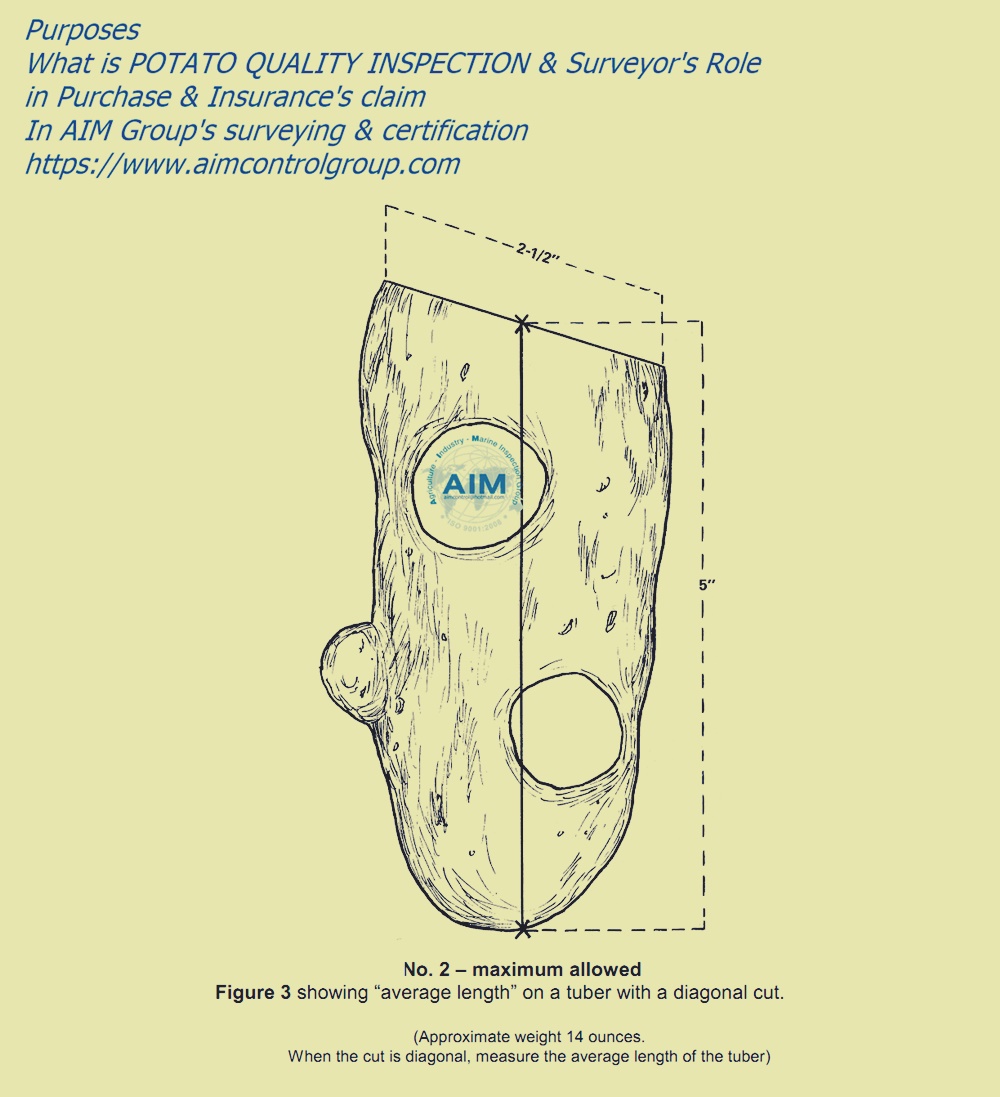
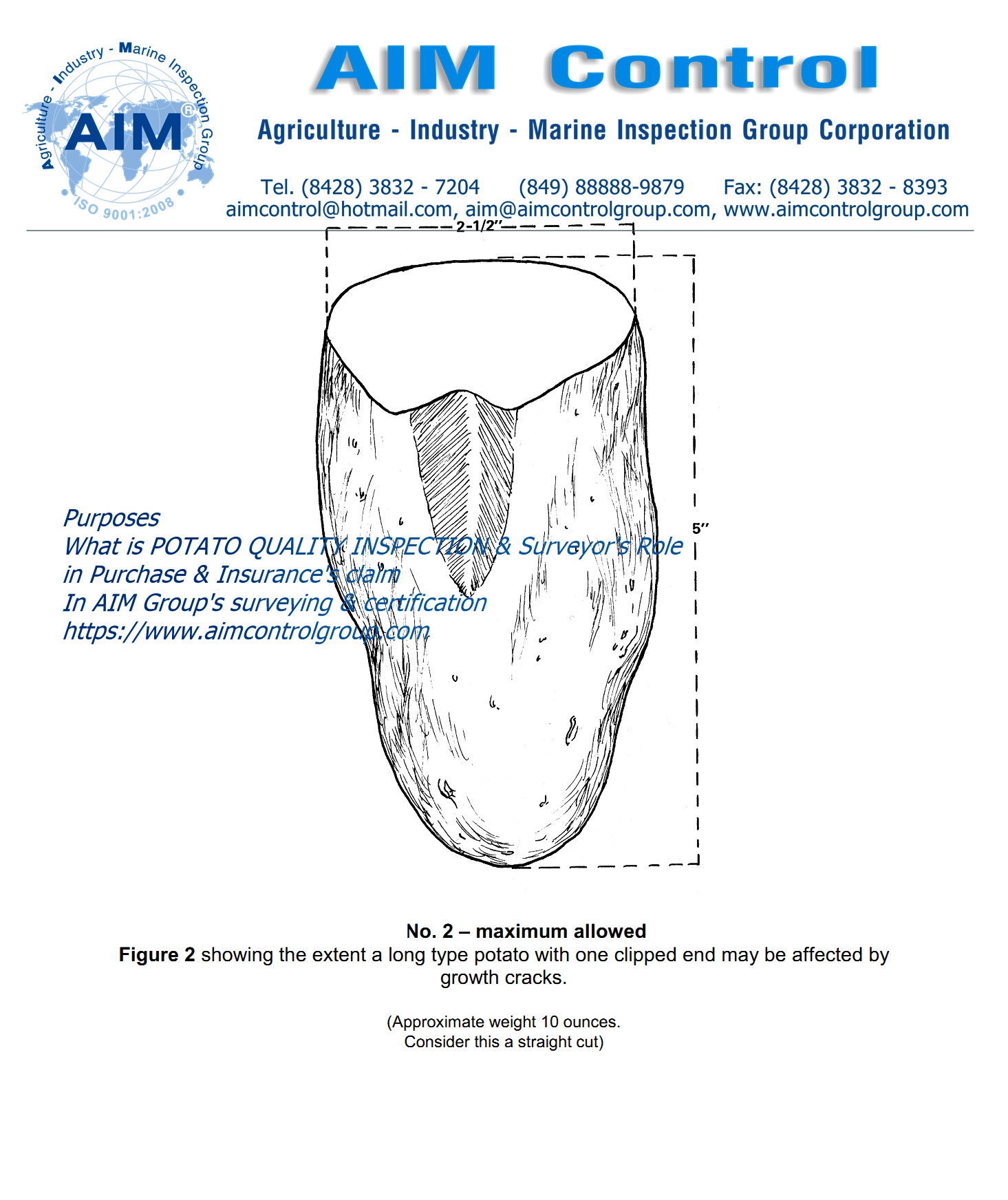
Corky Ring Spot (C)
Corky ring spot is caused by tobacco rattle virus which is transmitted by soilborne nematodes. Affected potatoes show brown rings, semicircles, loops and spots on the surface and similar brown rings, loops and spots in the interior tissues.
Dries Stems
The presence of dried stems is rather unusual and occurs during seasons of extreme drought when enlarged, tough stems do not readily separate from the tubers. Dried stems are not to be scored as a defect.
Elephant Hide (Q)
This defect, caused by environmental and physiological means, manifests itself as a severe roughened scaling of the skin unlike typical scab infections. The skin often appears darker and thicker than normal with deep checking, cracking or scaling.
Enlarged Lenticels (Q & C)
This injury occurs in some potato growing areas, especially where there are heavy soils and when soaking rains occur during or just preceding harvest. The injury may be found in either of two forms:
1) Numerous small blister-like areas around some of the enlarged lenticels with watery appearing spots slightly affecting the flesh immediately beneath the skin.
2) Numerous small, slightly sunken or pitted areas occurring around the lenticels which may or may not be enlarged.
External Surface Discoloration (C)
Discoloration can be caused by numerous reasons. lt can be caused by a rapid loss of moisture and oxidation, most apparent on skinned potatoes. This type of discoloration usually affects only the surface of the tuber.
Discoloration may also be caused by staining and diseases such as Black Dot. Black Dot describes a fungus that produces numerous dot-like, black microsclerotia that appear on tubers in conjunction with brown to gray surface discoloration. Even though it mostly affects the surface, it may penetrate the underlying flesh up to a depth of 1/16 inch (0.16 cm).
Firmness (C)
A higher grades, potatoes are required to be firm. ln the latter part of the storage season, sprouting may contribute to shriveling and flabbiness.
"Firm" means that the potato is not shriveled or flabby.
Scoring Guide
Damage:
When the potato is more than slightly shriveled or flabby.
Serious damage:
When the potato is excessively shriveled, spongy or flabby.
Folded Ends (Q)
Folded end is the term used to describe areas that fold inward on potatoes. These areas develop during the growing process and generally occur on the end of the potato.
Flattened or Depressed Areas (C)
These flattened or depressed areas are usually not found until after the potatoes have been in storage for several months. This defect is most often the result of pressure at points of contact with adjacent potatoes or floor.
Flea Beetle (Q)
This injury is caused by a small insect that feeds on or near the surface, which usually forms brown splinter-like pegs extending 1/8 (0.3175 cm) to 1/4 (0.635 cm) inch into the potato.
Freezing/Freezing Injury (Q & C)
Freezing. “Freezing" means that the potato is frozen or shows evidence of having been frozen.
Freezing may occur when temperatures drop below 30.9 F (-0.6111 C). Our inspectors will always clearly distinguish between potatoes in a frozen condition and those affected by freezing injury.
• Record pulp temperatures taken at various locations.
• Determine and record extent of injury in load and containers.
• Determine and record degree to which individual specimens are affected.
• Describe the pattern of freezing or freezing injury in clear, concise terms.
• Describe using general terms rather than percentages.
Noted:
Potatoes that are frozen are scored as serious damage against the restricted frozen/wet breakdown/soft rot tolerance.
Grass Damage (Q)
There are several grasses that cause damage to potatoes such as quack, nut and wire grass.
Greening (C)
Potatoes exposed to light either before or after harvest gradually tum green at the surface due to the development of chlorophyll. Greening that occurs before harvest is called sunburn. The degree of greening varies according to the type (incandescent, fluorescent, sun) and brightness of light, time period, and thickness of potato epidermis. Usually immature potatoes green more readily than mature ones.
Growth Cracks (Q)
Growth cracks may be caused by very rapid growth, as when a rainy period follows a long dry spell. Growth cracking usually follows the long axis of the potato and results from internal pressure exceeding the tensile strength of surface tissues during tuber enlargement.
Damage:
When affecting more than 1/2 the length in the aggregate on round varieties.
Serious damage:
When affecting more than 3/4 the length of the potato in the aggregate.
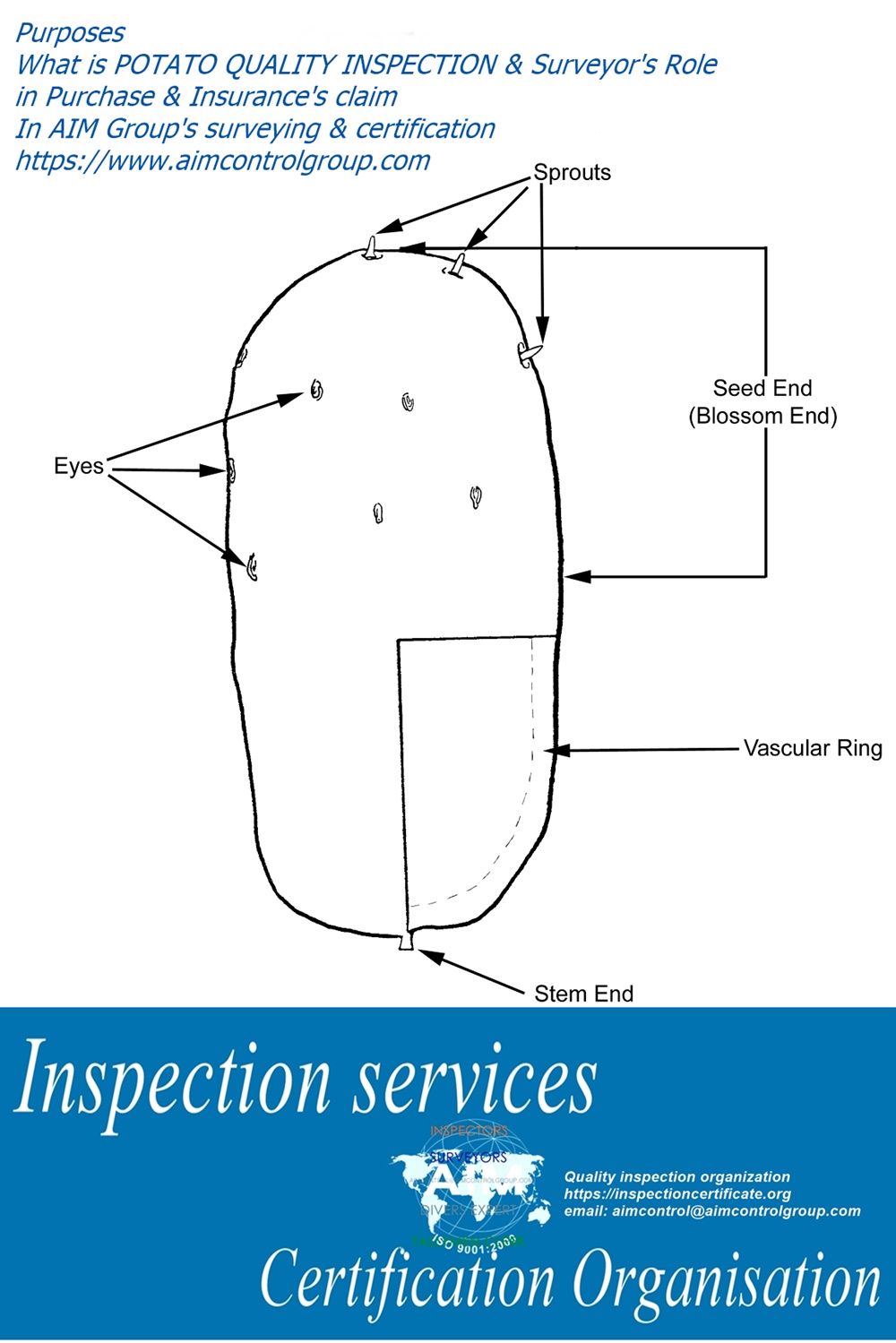
Grub Damage (Q)
This is a very common insect injury affecting potatoes. Grubs eat away at the skin and flesh of the potatoes leaving holes, usually of considerable size.
Mechanical Damage (Q)
“Mechanical Damage” is not a fully descriptive term for potatoes and should not be used on the certificate. Instead, describe the damage caused by harvesting and handling in terms of bruises or cuts.
Nematode (Root Knot) (Q)
This injury is found in Potatoes with advanced infestation usually have a roughened, irregular, bumpy or warty appearance due to the presence of galls on the outer surface.
Pink Eye (C)
Pink eye is characterized by pinkish blotches near the eyes and mostly around the blossom end of the tubers due to the pink underlying tissue. The internal tissue is firm to corky with pink to reddish-brown color. Black areas and cavities may also occur. The discolored tissues around the eyes may tum light brown, become wrinkled and cracked. Pink eye may be confused with late blight, but it does not have the brick-red granular tissue that is characteristic of blight. This defect, although rare, is sometimes seen in the lots.
Rhizoctonia (Black Scurf) (Q)
Rhizoctonia, commonly called black scurf, is present in all potato-growing areas.
Black or dark brown sclerotia develop on surfaces of mature tubers, which may be flat and superficial or large irregular lumps resembling soil that will not wash off. However, Rhizoctonia does not penetrate the tuber skin and may be scratched or flicked off with a fingernail.
Rodent and Bird Damage (Q)
Frequently rodents, such as field mice, gophers and rabbits gnaw into potatoes and cause cavities. Generally, the cavities made by rodents bear the marks of the teeth of the animal in the form of corrugations or ridges. Bird damage, such as is caused by chickens or other birds, is easily identified by the pit-like markings lining the cavity.
Rough Raised Netting (Q)
Netting affects the skin of potatoes; it may be raised and/or rough. However, netting is only defect when it is rough and raised.
Scabs (Q)
Common scab, of which there are three types — pitted, russet, and surface, and powdery scab are both soil inhabiting micro-organisms that have been known to mankind since the nineteenth century. Both pathogens are universally distributed over the potato growing regions of the world and are often described as fungi.
Pitted Scab (Q)
Pitted scab is the result of early infections, the uninjured tissues growing up around the affected areas causing the pitted depressions.
Russet Scab (Q)
Russet scab is a roughening, scurfing, or cracking of the tuber skin, sometimes occurring in localized areas or sometimes over most of the tuber surface.
Powdery Scab (Q)
This disease is characterized by jellylike areas under the skin which evolve into spore balls. When mature, these spore balls tum yellow, and then brown to black, and the epidermis (skin) splits and peels back to expose the dusty spore mass formed beneath. Sometimes these pustules enlarge to form cankers in the tuber.
Second Growth (Q)
Second growths are commonly attributed to high field temperatures and drought.
It may, however, result from regeneration following any condition causing irregular rates of tuber development such as uneven availability of nutrients or moisture, extremes in temperature, or vine defoliation from hail or frost. When growing conditions improve, resumption of tuber growth becomes evident as second growth.
Shape (Q)
The Grades for potatoes have the following requirements for shape:
Fairly well shaped.
Not seriously misshapen.
Definitions.
Well shaped. "Well shaped" means that the potato has the normal shape for the variety.
Fairly well shaped. "Fairly well shaped" means that the potato is not materially pointed, dumbbell-shaped or otherwise materially deformed.
Seriously misshapen. "Seriously misshapen" means that the potato is seriously pointed, dumbbell shaped or otherwise badly deformed. Potatoes that are seriously misshapen because of growth cracks or second growth should be inspected for those defects
Silver Scurf (C)
This is a fungal disease that primarily affects the skin and therefore affects the appearance of the potato. The occurrences of superficial brownish spots more or less circular in outline, constitutes the first symptoms. As the disease progresses the affected areas becomes silvery brown and may coalesce to cover most of the tuber surface. The affected areas may not be as conspicuous on dry potatoes, but when the potatoes are wet, the silvery appearance may sometimes be more readily seen.
Sunburn (Q)
Sunburn is caused by tubers being exposed directly to sunlight when insufficiently covered with soil.
Sunken Discolored Areas (C)
These areas vary in size and are sunken in comparison with the adjacent surface. They are darker than the skin color of the potato and vary in their degree of darkness from light brown to dark brown to black.
Tuber Moth Damage (C)
Most tuber moth damage occurs from larvae which hatch out either just prior to digging or after the potatoes are harvested. Eggs are deposited by the insect, usually at or near the eyes, and are most likely to be found on sunburned areas. The larvae hatch out and enter the potato, usually through the eye. They make tunnels at first close to the surface, and finally riddle the potatoes with deeply penetrating channels, making them unmarketable. Since this defect usually gets drastically worse in transit, the marketing quality is materially affected when any evidence is found at shipping point.
Wireworm (Q)
There are several types of wireworm holes that cause damage to potatoes. The type of hole will depend to a certain extent on the state of development of the potato at the time of the injury. When the injury is fairly fresh, it may appear as a small dirty hole.
INTERNAL DEFECTS
Internal defects. “internal defects" are defects which cannot be detected without cutting the potato.
The following specific defect name: net necrosis, stem end browning, vascular discoloration, internal brown spot, heat or drought necrosis, internal black spot, internal mahogany browning and internal pink to purple discoloration.
Sampling to Determine the Presence of Internal Defects
Sampling to accurately determine the percentage of internal defects is difficult and requires the inspector to use good judgment in all circumstances. While inspecting each sample the inspector will cut a minimum of five potatoes selected totally at random from that sample. A weight of sample is 9.0 kilograms.
Methods of Cutting to Determine Internal Defects
Internal defects in serious, cutting along the longitudinal axis in the middle of the potato's heart.
Internal defects in minor, cutting reveals a defect follow the appropriate method of cutting for the type of defect found.
-
- Cut tuber lengthwise and parallel to the flat side. (along longitudinal section)
-
- Cut slices laid down for examination. Potato cut in half-inch (0.79 cm thickness) slices (in horizontal section).
ln cutting to remove waste from net necrosis and other similar discoloration at the stem end, AIM Control’s inspectors will use a straight cut if the discoloration extends more than 1/2 of the circumference around the potato. The discoloration affects 1/2 or less of the circumference around the potato, the cut should be made on that particular side, using a curved cut so that an excessive amount of uninjured flesh will not be removed.
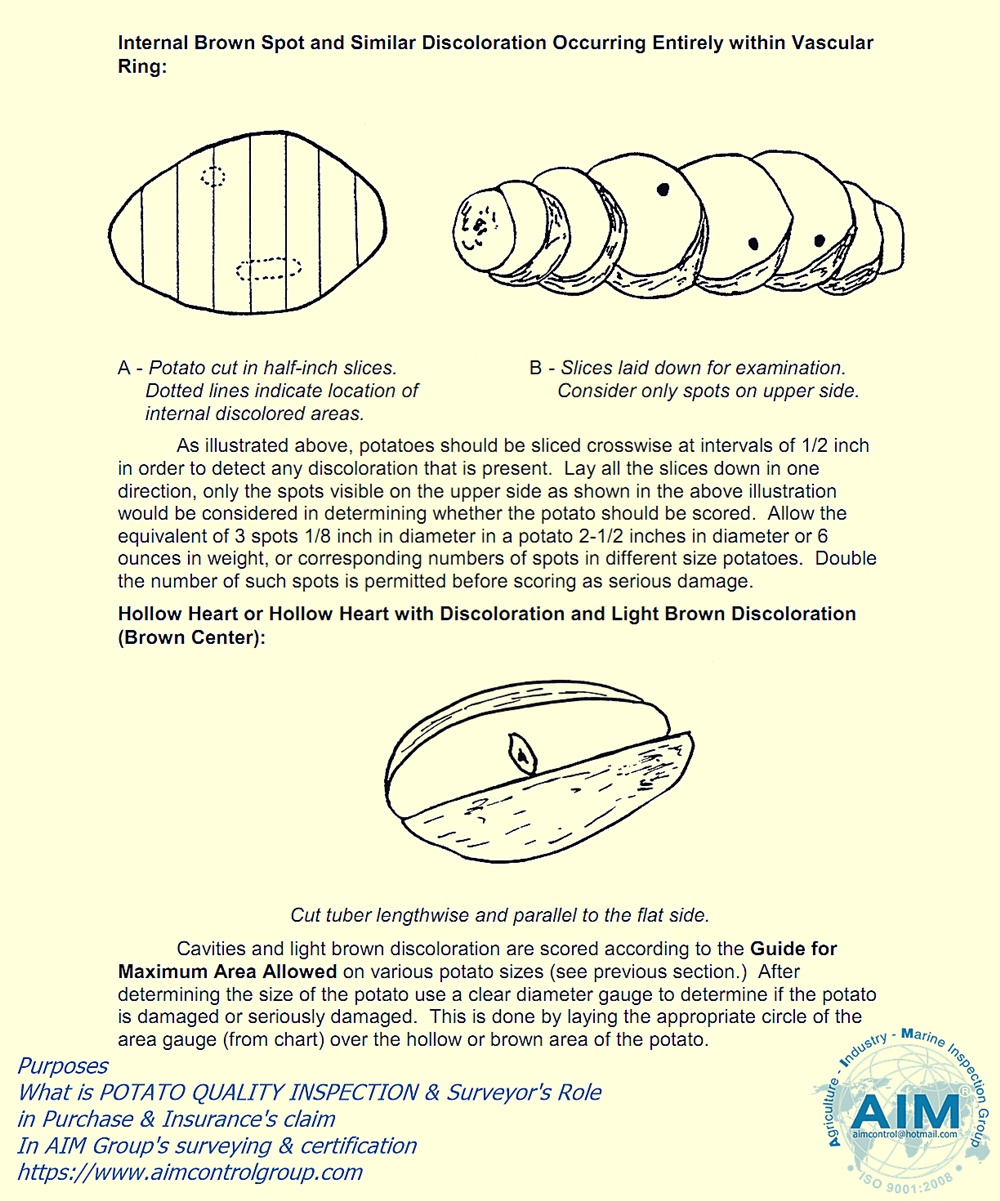
Blackheart (C)
The presence of blackheart generally occurs when the potatoes are exposed to high temperatures with an insufficient air supply.
Potatoes in all grades must be free from any amount of blackheart.
Heat or Drought Necrosis (Q)
Heat or drought necrosis causes slate-gray to golden-yellow or brown.
Hollow Heart or Hollow Heart with Discoloration (Q)
Hollow heart is a condition brought about by too rapid or irregular growth.
Damage:
When the area affected is more than that of a circle 1/2 inch (1.27 cm) in diameter
Serious damage:
When the area affected is more than that of a circle 3/4 inch (1.9 cm) in diameter
Ingrown Sprouts (C)
lngrown sprouts are sprouts that have actually grown back into the flesh of the potato.
Internal Black Spot (C)
The affected areas are usually at or near the surface and more often found at the shoulders of the stem end, although they occur on all parts of the potato.
Internal Brown Spot (Q)
The discolored and necrotic tissues, light yellowish-brown to dark rusty-brown in color, are firm, granular or corky in texture and are irregularly shaped and indefinite in outline. The spots usually range from 1/4 inch (0.635 centimeters) to 1/2 inch in diameter.
Damage:
When more than the equivalent of 3 scattered spots 1/8 inch (0.3175 cm) in diameter
Serious damage:
When more than the equivalent of 6 scattered spots 1/8 inch in diameter.
Internal Mahogany Browning (C)
This form of low temperature injury is caused by long storage below 38 F (3.3 C), but above the freezing point of potatoes.
Internal Pink to Purple Discoloration (C)
This discoloration generally affects the vascular ring area and often radiates in toward the center of the potato. The color of the affected tissue ranges from pink to various shades of purple and may be found throughout the length of the potato. The exact cause of this discoloration is unknown. lt has been speculated that it is a form of reversion (back to a parentage). Another suggested cause is field events such as extremes in temperatures or in moisture.
Internal Potato Necrosis (C)
Since the cause of this disease is an alfalfa mosaic virus that is transmitted by aphids, this defect occurs when potatoes are grown near alfalfa.
Light Brown Discoloration (Brown Center) (Q)
This is a condition that may develop while tubers are very small. The center of the potato shows areas of dead, brown cells. During the growing season these cells can split apart and form cavities (hollow heart).
Net Necrosis (C)
The outstanding characteristic of net necrosis is the presence of a network of necrotic strands, brown to brownish-black in color and sometimes extending throughout the flesh of the potato.
Stem End Browning (C)
The characteristics of stem end browning are the presence of dark brown to black streaks or areas which can be detected by clipping only the stem end.
Consequently, the value of the potato is not totally destroyed. The discoloration generally does not extend to any appreciable depth into the potato, but is rather uniform
near the surface.
Vascular Discoloration (C)
The vascular bundle is typically slightly darker than the natural flesh of the potato. However, when the vascular bundle is discolored to a degree that it is distinctly darker than the natural flesh of the potato the term vascular discoloration is used. lt is usually most severe at the stem end. Sudden killing of vines is one of several causes, others being verticillium wilt and fusarium wilt.
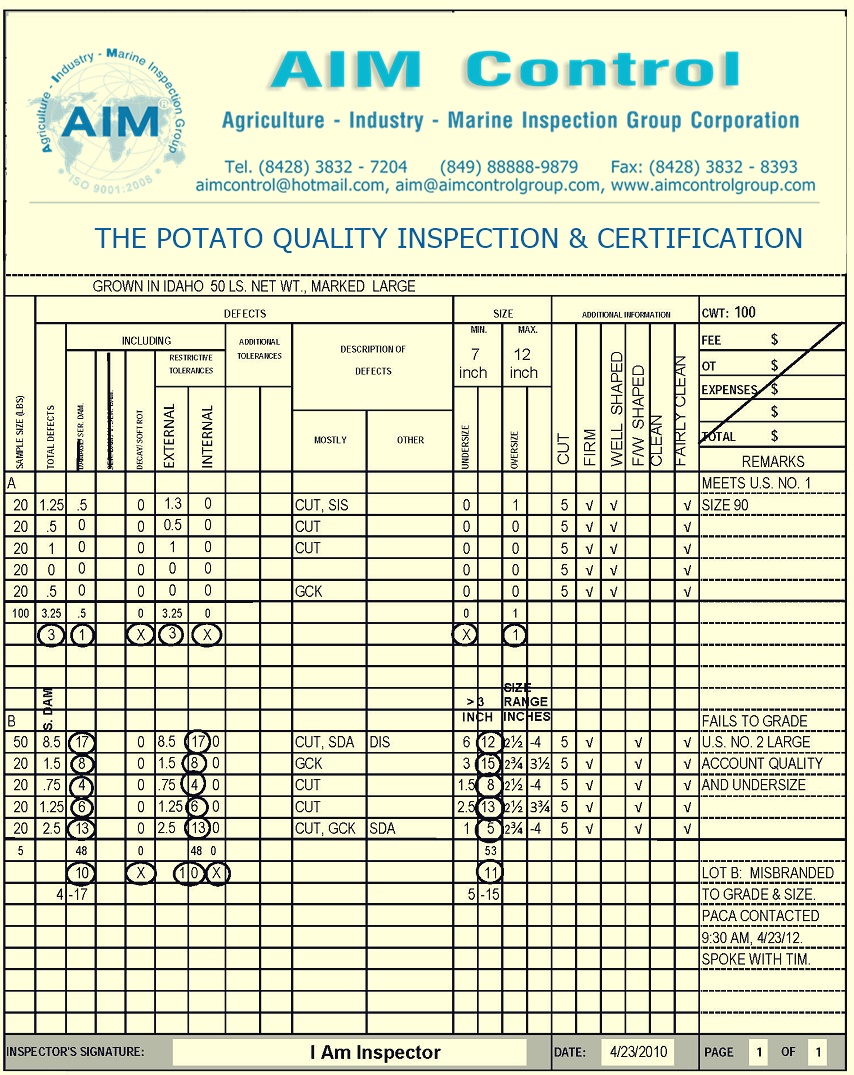
DRY ROT, SOFT ROT AND WET BREAKDOWN
Decays are progressive in nature, and may seriously affect the quality of potatoes. All decays should be tabulated separately on the inspection.
Alternaria Tuber Rot (Early Blight) (C)
The lesions on the tuber are of irregular size and shape and vary from 1/4 to 1 inch in diameter. They are brown to purplish-brown, slightly sunken with irregular borders and appear somewhat similar to those produced by late blight but are shallower.
Alternaria tuber rot is a serious storage and market disease that occurs in potatoes harvested during cool, humid weather. The infection opens the way for secondary infections by species of fusarium and other organisms. Alternaria tuber rot is a form of dry rot.
Bacterial Ring Rot (C)
Potatoes may appear to be healthy or have dark discolorations under the skin at the stem end or under the eyes. In some cases, they show a very characteristic
cracking extending only as lar as the vascular system. Upon cutting the potato near the stem end, in typical cases the vascular ring shows a yellowish-white or light brown discoloration.
Blackleg Tuber Rot (C)
This type of decay always enters through the stem end. A mild infection may result only in the discoloration of the vascular ring at the stem end. Decayed potatoes may be white or only slightly colored and cheesy or buttery in consistency but gradually tum black and slimy as the decomposition progresses.
Fusarium Tuber Rot (C)
This type of decay usually enters through injuries such as cuts and bruises, and may occur any place on the potato. The decaying tissues soon become sunken and the skin will have a wrinkled appearance. The color of the affected tissues varies from light to dark brown or even black. A distinct open cavity and/or masses of whitish mold are the two conclusive indicators of fusarium infection.
Jelly End Rot (Glassy End Rot) (C)
JeIIy end rot is identified by its jelly like, watery consistency occurring at the stem end of the potato, second growth knobs or pointed ends. This disorder is caused by conditions that interfere with the deposition of starch in the growing tissues. There is some evidence that fluctuations in moisture supply during the growing season may be responsible. Jelly end rot often dries leaving a shriveled flaky area.
Late Blight Tuber Rot (C)
When not complicated by secondary organisms, the decay is reddish-brown or purplish-brown in color and spreads irregularly from the surface through the flesh, like the diffusion of a brown stain.
Leak (C)
Infection usually takes place through cuts or bruises. The skin may show a brownish, somewhat water-soaked discoloration. The enlarging lesions are frequently sharply defined by a dark brown boundary line. The most characteristic symptom is the extremely watery nature of the affected tissue. The water is held by the tissues until pressure is applied, causing the skin to brake and release a yellowish or brownish liquid.
Pink Rot (C)
Pink rot occurs chiefly in cool, wet, poorly drained soils. External symptoms occur usually at the stem end, however at times the eyes and lenticels are infected. In white- skin potatoes the infected area turns dark brown, whereas in red-skin potatoes the first symptom is lading red. Blotchy purplish or black discoloration develops around the eyes and lenticels. Rotted tubers feel spongy or rubbery and the skin is easily sloughed off. When squeezed, droplets of liquid come from eyes and lenticels.
Sclerotium Rot (C)
This rot is usually found in the early crop of potatoes. lt seems to be associated with dirty potatoes, which, in all probability, were wet when dug and packed. This disease is marked by a watery, soft, mushy, odorless, and often colorless condition of the affected tissue. The lesions at times are yellowish to light brown and may appear as small, slightly sunken spots with brown margins. The consistency is granular-wet to watery, rather than slimy, and the soft, decaying tissue can easily be separated from the healthy tissue. As the disease develops, a rather fine, silky, white mycelium grows radially from a given point and forms fans closely appressed over the surface of the lesions and adjacent healthy tissues.
Slimy Soft Rot (C)
Slimy soft rots of potatoes are quite common and may be either of primary or secondary nature. The decaying parts tum into a stringy slime with a repulsive odor. As a secondary infection, it may follow other diseases or injuries, especially late blight tuber rot and scald or freezing injury.
Wet Breakdown (C)
Potatoes that are frozen will exhibit ice crystal formation within the tissues. Upon thawing, potatoes will exhibit a wet leaking condition known as wet breakdown.
Thank you for stopping by and reading our brief summary of AIM Group’s Quality potato inspection and certification!
Dr Capt. Nguyen Te Nhan / CEO
Email: ceo@aimcontrolgroup.com
WhatsApp : +84903615612 / +84888889879
Other news :
- Fruits quality control and certification
- Collateral Management International
- Coffee Inspection
- Reefer cargo inspection services
- Global nuts and seeds quality control inspection
- Wheat quality inspection
- QA QC on animal feed ingredients in aquaculture feed
- Agricultural products quality assurance aquaculture quality control
- Quality inspection Meat and bone meal
- Agricultural commodities quality inspection services

